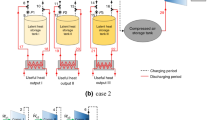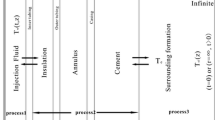Abstract
A novel water cycle compressed air energy storage system (WC-CAES) is proposed to improve the energy storage density (ESD) and round trip efficiency (RTE) of A-CAES. The new system decreases electricity consumption by recovering and reusing the hydraulic pressure of water. The thermodynamic characteristics of WC-CAES are evaluated by energy and advanced exergy analysis method. When the air storage pressure of WC-CAES is equal to the minimum storage pressure of A-CAES (4.2 MPa), the ESD and generalized storage density increase by 5.85 % and 32.41 %, respectively. When the air storage pressure increases to the same level as A-CAES (7.2 MPa), ESD and generalized storage density increase by 112 % and 162 %, respectively. In addition, the RTE increases by 1.6 % when the air storage pressure is 4.2 MPa. WC-CAES is therefore verified to be an effective way to improve the performance of conventional A-CAES.
Similar content being viewed by others
Abbreviations
- T :
-
Temperature, K
- P :
-
Pressure, kpa
- ṁ :
-
Mass flow rate, kg/m3
- h :
-
Specific enthalpy, KJ/kg
- Ẇ :
-
Power, KW
- π :
-
Pressure ratio
- η :
-
Efficiency
- ρ :
-
Density, kg/m3
- V :
-
Volume, m3
- t :
-
Time, s
- Ė :
-
Exergy, KJ/kg
- ex :
-
Specific exergy, KJ/kg
- D :
-
Generalized storage density, MJ/m3
- i :
-
State point
- cj :
-
Compressor
- ej :
-
Turbine
- in :
-
Inlet
- out :
-
Outlet
- oil :
-
Heat transfer oil
- d :
-
Destruction
- w :
-
Water
- hydro :
-
Hydro turbine
- charge :
-
Charge process
- discharge :
-
Discharge process
- is :
-
Isentropic
- AS :
-
Air/water (air) storage
- LC1, LC2 :
-
Low pressure compressor
- HC :
-
High pressure compressor
- HT1, HT2 :
-
High pressure turbine
- LT1-LT4 :
-
Low pressure turbine
- AS :
-
Air/water (air) storage tank
- HE :
-
Heat exchanger
- TV :
-
Throttle value
References
H. Lund and G. Salgi, The role of compressed air energy storage (CAES) in future sustainable energy systems, Energy Convers Manage, 50 (2009) 1172–1179.
M. Arbabzadeh, J. X. Johnson, G. A. Keoleian, P. G. Rasmussen and L. T. Thompson, Twelve principles for green energy storage in grid applications, Environ. Sci. Technol., 50 (2015) 1046–1055.
B. V. Mathiesen et al., Smart energy systems for coherent 100 % renewable energy and transport solutions, Appl. Energy, 145 (2015) 39–154.
M. C. Argyrou, P. Christodoulides and S. A. Kalogirou, Energy storage for electricity generation and related processes: technologies appraisal and grid scale applications, Renewable and Sustainable Energy Reviews, 94 (2018) 804–821.
T. M. I. Mahlia, T. J. Saktisahdan, A. Jannifar, M. H. Hasan and H. S. C. Matseelar, A review of available methods and development on energy storage: technology update, Renewable and Sustainable Energy Reviews, 33 (2014) 532–545.
H. Ibrahim, A. Ilinca and J. Perron, Energy storage systems-characteristics and comparisons, Renewable and Sustainable Energy Reviews, 12 (2008) 1221–1250.
F. Klumpp, Comparison of pumped hydro, hydrogen storage and compressed air energy storage for integrating high shares of renewable energies-potential, cost-comparison and ranking, J. of Energy Storage, 8 (2016) 119–128.
H. Chen, T. N. Cong, W. Yang, C. Tan, Y. Li and Y. Ding, Progress in electrical energy storage system: a critical review, Progress in Natural Science, 19 (2009) 291–312.
M. Raju and S. K. Khaitan, Modeling and simulation of compressed air storage in caverns: a case study of the Huntorf plant, Appl. Energy, 89 (2012) 474–481.
M. Budt, D. Wolf, R. Span and J. Yan, A review on compressed air energy storage: basic principles, past milestones and recent developments, Appl. Energy, 170 (2016) 250–268.
J. Liu and J. Wang, A comparative research of two adiabatic compressed air energy storage systems, Energy Convers. Manage., 108 (2016) 566–578.
X. Zhang et al., A near-isothermal expander for isothermal compressed air energy storage system, Appl. Energy, 225 (2018) 955–964.
A. Odukomaiya, E. Kokou, Z. Hussein, A. Abu-Heiba, S. Graham and A. M. Momen, Near-isothermal-isobaric compressed gas energy storage, J. of Energy Storage, 12 (2017) 276–287.
J. Guanwei, X. Weiqing, C. Maolin and S. Yan, Micron-sized water spray-cooled quasi-isothermal compression for compressed air energy storage, Exp. Therm. Fluid Sci., 96 (2018) 470–481.
S. Tong, Z. Cheng, F. Cong, Z. Tong and Y. Zhang, Developing a grid-connected power optimization strategy for the integration of wind power with low-temperature adiabatic compressed air energy storage, Renew. Energy, 125 (2018) 73–86.
S. Houssainy, M. Janbozorgi and P. Kavehpour, Theoretical performance limits of an isobaric hybrid compressed air energy storage system, J. of Energy Resources Technology, 140 (2018) 101201–101209.
Y. M. Kim and D. Favrat, Energy and exergy analysis of a micro-compressed air energy storage and air cycle heating and cooling system, Energy, 35 (2010) 213–220.
Y. M. Kim, D. G. Shin and D. Favrat, Operating characteristics of constant-pressure compressed air energy storage (CAES) system combined with pumped hydro storage based on energy and exergy analysis, Energy, 36 (2011) 6220–6233.
E. Yao, H. Wang, L. Liu and G. Xi, A novel constant-pressure pumped hydro combined with compressed air energy storage system, Energies, 8 (2015) 154–171.
Y. Mazloum, H. Sayah and M. Nemer, Exergy analysis and exergoeconomic optimization of a constant-pressure adiabatic compressed air energy storage system, J. of Energy Storage, 14 (2017) 192–202.
Z. Wang, W. Xiong, D. S. K. Ting, R. Carriveau and Z. Wang, Conventional and advanced exergy analyses of an underwater compressed air energy storage system, Appl. Energy, 180 (2016) 810–822.
V. C. Patil and P. I. Ro, Energy and exergy analysis of ocean compressed air energy storage concepts, J. of Engineering, 2018 (2018) 1–14.
Z. Guo, G. Deng, Y. Fan and G. Chen, Performance optimization of adiabatic compressed air energy storage with ejector technology, Appl. Therm. Eng., 94 (2016) 193–197.
L. X. Chen, P. Hu, P. P. Zhao, M. N. Xie, D. X. Wang and F. X. Wang, A novel throttling strategy for adiabatic compressed air energy storage system based on an ejector, Energy Convers. Manage., 158 (2018) 50–59.
L. X. Chen, M. N. Xie, P. P. Zhao, F. X. Wang, P. Hu and D. X. Wang, A novel isobaric adiabatic compressed air energy storage (IA-CAES) system on the base of volatile fluid, Appl Energy, 210 (2018) 198–210.
R. Morgan, S. Nelmes, E. Gibson and G. Brett, Liquid air energy storage-analysis and first results from a pilot scale demonstration plant, Appl. Energy, 137 (2015) 845–853.
H. Guo, Y. Xu, H. Chen and X. Zhou, Thermodynamic characteristics of a novel supercritical compressed air energy storage system, Energy Convers. Manage., 115 (2016) 167–177.
C. Xie, Y. Hong, Y. Ding, Y. Li and J. Radcliffe, An economic feasibility assessment of decoupled energy storage in the UK: with liquid air energy storage as a case study, Appl. Energy, 225 (2018) 244–257.
H. Guo, Y. Xu, H. Chen, C. Guo and W. Qin, Thermodynamic analytical solution and exergy analysis for supercritical compressed air energy storage system, Appl. Energy, 199 (2017) 96–106.
X. Wang, W. Li, X. Zhang, Y. Zhu, W. Qin and H. Chen, Flow characteristic of a multistage radial turbine for supercritical compressed air energy storage system, Proceedings of the Institution of Mechanical Engineers, Part A: J. of Power and Energy, 232 (2017) 622–640.
B. Ameel et al., Thermodynamic analysis of energy storage with a liquid air rankine cycle, Appl. Therm. Eng., 52 (2013) 130–140.
Y. Saad, R. Younes, S. Abboudi and A. Ilinca, Hydro-pneumatic storage for wind-diesel electricity generation in remote sites, Appl. Energy, 231 (2018) 1159–1178.
A. Odukomaiya, A. Abu-Heiba, S. Graham and A. M. Momen, Experimental and analytical evaluation of a hydro-pneumatic compressed-air ground-level integrated diverse energy storage (GLIDES) system, Appl. Energy, 221 (2018) 5–85.
J. Liu and J. Wang, A comparative research of two adiabatic compressed air energy storage systems, Energy Convers. Manage., 108 (2016) 566–578.
W. Xusheng et al., Multi-objective optimization of a gas turbine-based CCHP combined with solar and compressed air energy storage system, Energy Convers. Manage., 164 (2018) 93–101.
Y. Şöhret, E. Açikkalp, A. Hepbasli and T. H. Karakoc, Advanced exergy analysis of an aircraft gas turbine engine: splitting exergy destructions into parts, Energy, 90 (2015) 1219–1228.
Q. He, H. Liu, Y. Hao, Y. Liu and W. Liu, Thermodynamic analysis of a novel supercritical compressed carbon dioxide energy storage system through advanced exergy analysis, Renew Energy, 127 (2018) 835–849.
T. Koroglu and O. S. Sogut, Conventional and advanced exergy analyses of a marine steam power plant, Energy, 163 (2018) 392–403.
F. Petrakopoulou, G. Tsatsaronis, T. Morosuk and A. Carassai, Conventional and advanced exergetic analyses applied to a combined cycle power plant, Energy, 41 (2012) 146–152.
C. Guo et al., Performance analysis of compressed air energy storage systems considering dynamic characteristics of compressed air storage, Energy, 135 (2017) 876–888.
Z. Wang, W. Xiong, D. S. K. Ting, R. Carriveau and Z. Wang, Comparison of underwater and underground CAES systems for integrating floating offshore wind farms, J. of Energy Storage, 14 (2017) 276–282.
E. W. Lemmon, M. L. Huber and M. O. McLinden, NIST Standard Reference Database 23: Reference Fluid Thermodynamic and Transport Properties-REFPROP, Version 9.1, National Institute of Standards and Technology (2013).
L. X. Chen, P. Hu, P. P. Zhao, M. N. Xie, D. X. Wang and F. X. Wang, A novel throttling strategy for adiabatic compressed air energy storage system based on an ejector, Energy Convers. Manage., 158 (2018) 50–59.
Acknowledgments
The authors would like to acknowledge the financial support by the Key Research and Development Program of Shandong province (No. 2017GGX40104) and the Fundamental Research Funds of Shandong University (No. 2017JC039) that facilitated this research.
Author information
Authors and Affiliations
Corresponding authors
Additional information
Zhen Xu received the B.S. in Chemical Equipment and Machinery from the Qingdao Institute of Chemical Technology in 1999, and the Ph.D. in Power Engineering and Engineering Thermophysics from Chinese Academy of Sciences in 2006. He is currently an Associate Professor with the Shandong University. His research interests include high efficiency waste heat utilization and energy saving.
Haiyang Yang received his Master’s in Power Engineering from Shandong University in 2020 and is currently a Ph.D. student at Institute of Engineering Thermophysics, Chinese Academy of Sciences. His research direction includes the optimization of the cogeneration system coupled with compressed air energy storage and the development of high-efficiency, low-carbon and low-nitrogen combustion chambers.
Yingchun Xie received the B.S. in Chemical Equipment and Machinery from the Qingdao Institute of Chemical Technology in 1999, and the Ph.D. in Port, Coastal and Offshore Engineering from Ocean University of China in 2018. She is currently a Professor with the Ocean University of China. Her research interests include integration and optimization of the thermal system, and working environment adaptability research of offshore oil platform.
Jinchi Zhu received the B.S. in Mechanical Design, Manufacturing and Automation from the Ocean University of China in 2017, and the M.S. in Power Engineering with the Ocean University of China in 2020. His current research interests include fluid mechanics and computational fluid dynamics.
Chaoqun Liu received his B.S. in Mechanical Engineering and Automation from Qingdao University of Science and Technology in 2020 and is currently a Master’s student in Mechanical Engineering from Ocean University of China. His current research direction is compressed air energy storage based on offshore wind power.
Rights and permissions
About this article
Cite this article
Xu, Z., Yang, H., Xie, Y. et al. Thermodynamic analysis of a novel adiabatic compressed air energy storage system with water cycle. J Mech Sci Technol 36, 3153–3164 (2022). https://doi.org/10.1007/s12206-022-0546-3
Received:
Revised:
Accepted:
Published:
Issue Date:
DOI: https://doi.org/10.1007/s12206-022-0546-3




